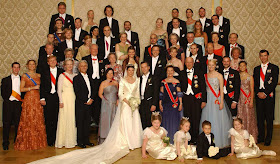HM Queen Victoria of the United Kingdom and HRH Prince Albert of Saxe-Coburg and Gotha
February 10, 1840
London, United Kingdom
Most of the wedding gowns we highlight here feature shades of white, in tune with general bridal fashion in many of the cultures our royals hail from. Today’s gown is the one often credited with starting the “white wedding” trend.
Queen Victoria came to the throne in 1837 at the age of 18. She married her cousin Prince Albert in 1840; their relationship, though strongly encouraged by their mutual uncle King Leopold of the Belgians, was a love affair that would dip into obsession. She had done the proposing, as dictated by protocol.
Victoria’s wedding dress was chosen under different circumstances than most royal wedding gowns were; she was no princess entering a new family, she was a reigning monarch with national industries to support and an impression to make. Hoping to foster a revival of interest in British lacemaking, she selected British-made Honiton lace as the prime feature of her dress, in accents and a flounce over the skirt. The lace was complemented by her choice of heavy white silk from Spitalfields in London.
 |
| The lace flounce |
The whole dress – designed by artist William Dyce – was made in England. It featured a fashionably low neckline with a full pleated skirt and an 18 foot train. The train was carried into the Chapel Royal at St. James’ Palace for the ceremony by 12 daughters of peers, all wearing white accented by white roses. (One of the trainbearers would later write that there were far too many of them for the train, and they kept tripping over each other.)
 |
| Franz Xavier Winterhalter's portrait of Victoria in her wedding attire was actually commissioned by Victoria as a present for Albert for their 1847 anniversary |
Though she chose a modest wreath of orange flowers to adorn her head and fasten her short lace veil instead of a crown or tiara, she did select other jewels for the day: the
sapphire and diamond brooch presented to her the day before the wedding by Albert, her Turkish diamond necklace and earrings, and her insignia for the Order of the Garter. Underneath it all, her feet were clad in white slippers.
 |
| On display today |
Images of the royal wedding were widely reproduced and Victoria’s attire was widely commented on. She did indeed spur renewed interest in the British lacemaking industry, and wealthy brides did copy her white color scheme, but she wasn't the first to wear white and the transition to white as the bridal norm was far from instantaneous. It would take decades, and the rise of a middle class with a disposable income (plus other advancements), before white really became the bridal color of note.
Her shoes and the sleeve of the gown
Victoria’s dress was criticized by some at the time for being too simple and too conservative, but she loved it and cherished it for the rest of her life. The lace flounce was removed and worn to other significant occasions. Her daughter Beatrice was permitted to wear it for her own wedding, in 1885. Sentimental to the end, Queen Victoria was buried with her wedding veil.
Victoria wearing her lace flounce later in life; Princess Beatrice wearing the lace on her wedding gown
Queen Victoria and Prince Albert were married for 21 years before Albert’s early death sent her into seclusion and a mourning period that lasted the rest of her life. Victoria and Albert had nine children; their children and grandchildren married into so many different royal families that Victoria is nicknamed the Grandmother of Europe. Most of Europe’s monarchs today can trace their family tree back to Victoria, sometimes more than once.
Queen Victoria’s wedding gown is still around today, though it is no longer united with that wonderful lace flounce. As you can imagine, it’s very fragile, and it has recently undergone a new round of conservation efforts. It’s on display at the newly renovated Kensington Palace.
What do you think about the most historical gown we've covered so far?
Photos: The Royal Collection/Historic Royal Palaces


























































